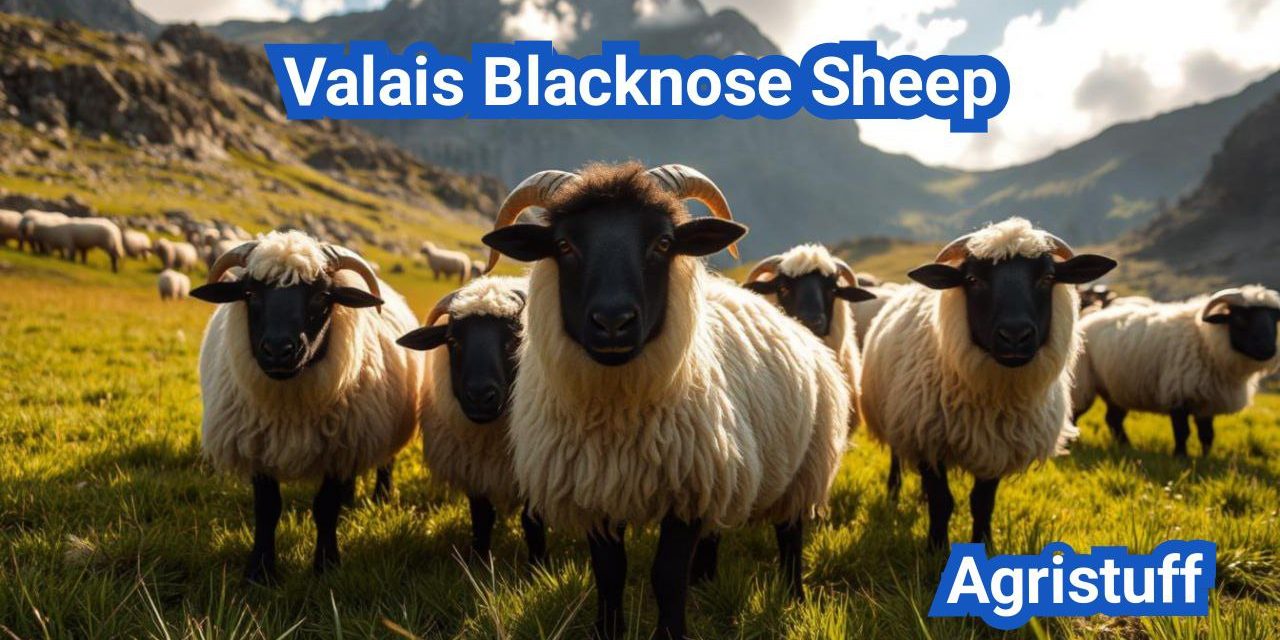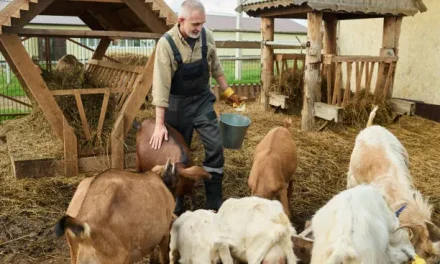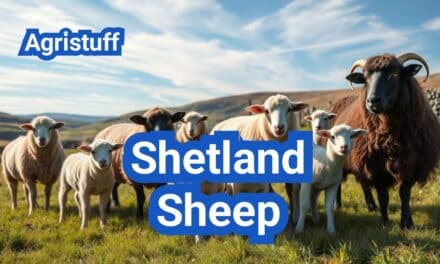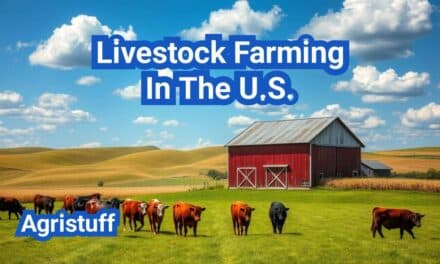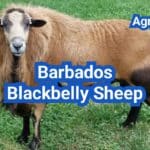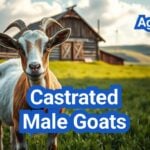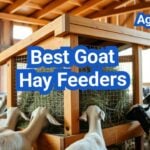The Valais Blacknose Sheep is a rare and endearing breed originating from the Valais region of Switzerland. Known for their distinctive black and white markings, they are considered one of the cutest sheep breeds.
This breed has gained popularity worldwide due to its unique characteristics and the efforts of the valais blacknose sheep society to promote and preserve it. In this article, we will delve into the history, characteristics, and significance of the Valais Blacknose Sheep.
Key Takeaways
- Origin and history of the Valais Blacknose Sheep breed
- Unique characteristics that make them special
- The role of the valais blacknose sheep society in their preservation
- Why they are considered one of the cutest sheep breeds
- Information on their distinctive black and white markings
The Origins and History of Valais Blacknose Sheep
The history of the Valais Blacknose Sheep is deeply intertwined with the Valais region of Switzerland. This breed has a rich heritage that dates back to the 15th century.
Swiss Heritage in the Valais Region
The Valais Blacknose Sheep originated in the Valais region, a valley in the Swiss Alps. The harsh alpine climate and the region’s isolation contributed to the breed’s distinct characteristics. The breed was first mentioned around the year 1400, highlighting its ancient roots.
Historical Development of the Breed
Over the centuries, the Valais Blacknose Sheep developed into a robust and hardy breed, well-suited to the challenging mountainous terrain. The breed was recognized officially in 1962, marking a significant milestone in its history.
Global Recognition and Spread
The Valais Blacknose Sheep gained international recognition and was imported to new countries. Notably, they were introduced to the UK in 2014 and to the USA in 2016 as part of an “upgrading program.” This global spread has contributed to the breed’s growing popularity among sheep breeders worldwide.
| Year | Event | Location |
|---|---|---|
| 1400 | First mention of the breed | Valais Region, Switzerland |
| 1962 | Official recognition of the breed | Switzerland |
| 2014 | Introduction to the UK | United Kingdom |
| 2016 | Introduction to the USA | United States |
The history of the Valais Blacknose Sheep is a testament to the breed’s resilience and adaptability. From its origins in the Swiss Alps to its global presence today, the breed continues to captivate sheep enthusiasts around the world.
Understanding Valais Blacknose Sheep Characteristics

Valais Blacknose Sheep are renowned for their striking appearance and robust build. Their unique characteristics make them a popular choice among sheep breeders and enthusiasts.
Distinctive Black and White Markings
One of the most distinctive features of Valais Blacknose Sheep is their black nose, ears, and eye rims, which contrast with their white fleece. This striking color combination is a hallmark of the breed and contributes to their visual appeal.
Size and Weight Specifications
Valais Blacknose Sheep are known for their robust physique. Rams typically weigh between 80-125 kg, while ewes weigh between 70-90 kg. This size difference is significant and is an important consideration for breeders.
Rams vs. Ewes Differences
The size and weight differences between rams and ewes are notable. Rams are generally larger and heavier, with a more muscular build. Ewes, on the other hand, are slightly smaller and more compact.
Growth Patterns
Valais Blacknose Sheep exhibit a consistent growth pattern. They are born with a relatively small birth weight, typically around 3-4 kg, and grow rapidly during the first year. Proper nutrition and care are essential during this period to ensure optimal growth.
Lifespan and Development Stages
Valais Blacknose Sheep have an average lifespan of 10-15 years. They go through various development stages, from lambhood to maturity. Understanding these stages is crucial for providing appropriate care and management.
By recognizing the unique characteristics of Valais Blacknose Sheep, breeders can better appreciate the breed’s value and work towards maintaining its high standards.
The Official Valais Blacknose Breed Standard
The official breed standard for Valais Blacknose Sheep provides a detailed description of the ideal characteristics of this breed. This standard is crucial for breeders, judges, and enthusiasts to understand and appreciate the unique features of these sheep.
Head and Facial Features
The Valais Blacknose Sheep is known for its distinctive black and white markings, particularly on its face. The breed standard specifies that the face should be black, with a well-defined nose and a distinctive black stripe running down to the muzzle. The eyes should be dark and expressive.
Body Conformation Requirements
The body of a Valais Blacknose Sheep should be well-proportioned, with a sturdy build and a deep chest. The breed standard emphasizes the importance of a strong, muscular neck and well-sprung ribs. The overall conformation should reflect a balance between strength and agility.
Wool and Fleece Standards
The wool of the Valais Blacknose Sheep is one of its most prized features. The breed standard requires that the wool be white, with a staple length of around 10 cm. The fleece should be free from twisting or irregular locks, and it should have a soft, fine texture.
Disqualifying Traits
Certain traits can disqualify a Valais Blacknose Sheep from being considered a true representative of the breed. These include any significant deviation from the black and white color pattern, incorrect fleece characteristics, and poor body conformation. Understanding these disqualifying traits is essential for maintaining the breed’s integrity.
In summary, the Valais Blacknose breed standard is a comprehensive guide that outlines the ideal characteristics of these sheep, from their head and facial features to their body conformation and wool quality.
Valais Blacknose Temperament and Behavior

Valais Blacknose Sheep are renowned for their gentle disposition, making them an excellent choice for farmers and hobbyists alike. Their temperament is characterized by a calm and friendly nature, which makes them easy to handle and interact with.
Docile Nature and Friendliness
The docile nature of Valais Blacknose Sheep is one of their most appealing attributes. They are known to be exceptionally friendly, which makes them a joy to be around. As a breeder notes,
“Valais Blacknose Sheep are incredibly affectionate and thrive on human interaction.”
This friendly demeanor is a significant factor in their growing popularity.
Interaction with Humans
Valais Blacknose Sheep are highly social and enjoy interacting with humans. They are known to be curious and will often approach people, making them ideal for farms that offer agritourism activities or for those who simply enjoy the company of their animals.
Flock Behavior and Socialization
These sheep are very social animals that thrive in the company of other sheep. They have a strong flocking instinct, which means they prefer to be in groups. Proper socialization from an early age is crucial for developing well-adjusted animals.
Training Potential
Due to their intelligence and friendly nature, Valais Blacknose Sheep are relatively easy to train. They respond well to positive reinforcement techniques, making training a straightforward process. Their trainability, combined with their docile nature, makes them an excellent choice for various farming purposes.
In summary, the Valais Blacknose Sheep’s temperament and behavior make them a highly desirable breed for many farmers and animal enthusiasts. Their friendly nature, social behavior, and trainability contribute to their appeal, making them a valuable addition to any farm or homestead.
How to Set Up Housing for Valais Blacknose Sheep
Creating a suitable living environment is vital for the overall health of Valais Blacknose Sheep. Proper housing protects them from extreme weather conditions and predators, ensuring their well-being.
Shelter Requirements
Adequate shelter is crucial for Valais Blacknose Sheep. It shields them from harsh weather, providing a comfortable environment.
Winter Housing Considerations
During winter, the shelter should be draft-free and dry, protecting the sheep from cold winds and moisture.
Summer Shade and Ventilation
In the summer, it’s essential to provide shade and ensure good ventilation to prevent heat stress.
Fencing and Containment
Sturdy fencing is necessary to contain Valais Blacknose Sheep safely. The fencing should be at least 5 feet tall to prevent jumping.
Space Requirements Per Animal
Each Valais Blacknose Sheep requires sufficient space to move around comfortably. A general guideline is to provide at least 10-15 square feet per sheep in the shelter.
Bedding and Flooring Options
The choice of bedding is important for the health and comfort of the sheep. Common options include straw, hay, or sand.
When setting up housing, it’s also important to consider the ease of cleaning and maintenance. A well-designed shelter can significantly reduce the workload.
| Housing Aspect | Requirements |
|---|---|
| Shelter Size | 10-15 square feet per sheep |
| Fencing Height | At least 5 feet |
| Bedding | Straw, hay, or sand |
Feeding and Nutrition Guide for Valais Blacknose Sheep

Valais Blacknose Sheep require a well-balanced diet to maintain their health and productivity. Their nutritional needs are critical to their overall well-being and must be carefully managed.
Daily Dietary Requirements
Valais Blacknose Sheep need a diet rich in nutrients, including high-quality pasture, hay, and supplements. Their daily dietary requirements include a mix of energy, protein, and essential minerals.
Pasture Management
Effective pasture management is crucial for the health of Valais Blacknose Sheep. Pastures should be rotationally grazed to maintain quality and prevent overgrazing.
Supplemental Feeding
In addition to pasture, Valais Blacknose Sheep may require supplemental feeding, including hay and grains. The quality of these supplements is vital.
Hay and Forage Selection
High-quality hay and forage are essential for the nutritional well-being of Valais Blacknose Sheep. Legume hays, such as alfalfa, are particularly nutritious.
Grain and Concentrate Guidelines
Grain and concentrate feeding should be done according to the sheep’s nutritional needs, taking into account their age, size, and production level.
Water Requirements
Access to clean, fresh water is essential for Valais Blacknose Sheep. Water quality directly impacts their health and productivity.
Mineral and Vitamin Supplementation
Mineral and vitamin supplements are necessary to ensure that Valais Blacknose Sheep receive a balanced diet. Deficiencies can lead to health issues.
By understanding and implementing these feeding and nutrition guidelines, farmers can ensure the health and productivity of their Valais Blacknose Sheep.
Health Management of Valais Blacknose Sheep

Maintaining the health of Valais Blacknose Sheep involves several key practices. Effective health management is crucial for preventing diseases and ensuring the overall well-being of the flock.
Common Health Issues
Valais Blacknose Sheep are prone to certain health issues, including parasites and hoof problems. Internal parasites, such as worms, can significantly impact their health if not managed properly. Regular monitoring and preventive measures are essential to mitigate these risks.
Vaccination Schedule
Implementing a proper vaccination schedule is vital to protect Valais Blacknose Sheep from common diseases. Consult with a veterinarian to determine the most appropriate vaccination program for your flock, taking into account factors like region and potential disease exposure.
Parasite Prevention and Treatment
Regular parasite control measures are necessary to prevent infestations. This includes administering deworming medications at appropriate intervals and maintaining clean living conditions to reduce the risk of parasite-related health issues.
Hoof Care and Maintenance
Proper hoof care is essential to prevent lameness and other hoof-related problems. Regular trimming and inspection of hooves can help identify issues early, allowing for timely intervention.
When to Call a Veterinarian
It’s crucial to know when to seek veterinary assistance. Signs of illness or distress, such as unusual behavior, loss of appetite, or visible signs of disease, should prompt a call to a veterinarian. Early intervention can significantly improve outcomes in cases of health issues.
By following these health management practices, farmers can help ensure the health and productivity of their Valais Blacknose Sheep flock. Regular veterinary care, combined with preventive measures, plays a key role in maintaining the overall health of these animals.
Valais Blacknose Sheep Wool Production and Uses
Valais Blacknose Sheep wool is highly prized for its quality and characteristics, making it a valuable resource for various textile applications. The wool produced by these sheep is not only soft and warm but also highly durable, making it suitable for a range of products.
Wool Quality and Characteristics
The wool of Valais Blacknose Sheep is known for its excellent crimp and elasticity, which contributes to its durability and versatility. It is often described as having a soft, fine texture that is ideal for crafting high-quality textiles. The fleece is typically white with black markings, although the wool itself is usually processed to be free of these markings.
Shearing Techniques and Timing
Shearing is a critical process in managing the wool of Valais Blacknose Sheep. It is typically done once or twice a year, depending on factors such as climate and the individual sheep’s condition. Proper shearing techniques are essential to ensure the quality of the wool and the health of the sheep.
Shearers must be skilled to avoid causing stress or injury to the animals. The timing of shearing is also crucial, as it needs to be done before the wool becomes too long and uncomfortable for the sheep, but not so early that it leaves them exposed to cold temperatures.
Processing Valais Blacknose Wool
After shearing, the wool is processed to prepare it for use. This involves cleaning, sorting, and carding the fibers to align them in the same direction. The processed wool can then be spun into yarn, which is used for knitting or weaving.
Valais Blacknose wool is particularly suited to felting, a process that involves matting the wool fibers together using heat, moisture, and pressure. This results in a dense, thick fabric that is highly valued for its warmth and durability.
Commercial and Artisanal Applications
The wool of Valais Blacknose Sheep is used in a variety of applications, ranging from commercial textile production to artisanal crafts. Its high quality makes it suitable for producing clothing, accessories, and home textiles that are both functional and luxurious.
In addition to its practical uses, Valais Blacknose wool is also valued for its role in supporting sustainable agriculture and rural economies. The production and sale of products made from this wool can provide a significant income stream for farmers and artisans.
Breeding Valais Blacknose Sheep Successfully

To breed Valais Blacknose Sheep successfully, farmers must focus on several key areas, including the selection of breeding stock and preparation for the breeding season. Effective breeding requires a comprehensive understanding of the breed’s characteristics and needs.
Selecting Breeding Stock
Choosing the right breeding stock is crucial for maintaining the quality and integrity of the Valais Blacknose Sheep breed. Superior breeding stock should exhibit the breed’s characteristic features, such as distinctive black and white markings and robust health. Farmers should evaluate potential breeding animals based on their genetic lineage, health records, and conformity to the breed standard.
Breeding Season Preparation
Preparing for the breeding season involves several steps, including ensuring that both rams and ewes are in optimal health. Nutritional supplementation may be necessary to support the reproductive health of breeding animals. Farmers should also review their breeding program’s goals and adjust their strategy as needed to achieve desired outcomes.
Pregnancy Care
Proper care during pregnancy is vital for the health of both the ewe and the developing lamb. Pregnant ewes require a nutritious diet and regular monitoring to detect any potential issues early. Farmers should also ensure that pregnant ewes have access to safe and comfortable living conditions.
Lambing Process and Assistance
The lambing process is a critical period that requires careful monitoring. Farmers should be prepared to provide assistance if necessary to ensure a safe delivery. Understanding the signs of lambing and having a plan in place for potential complications are essential for successful lambing.
Lamb Care and Management
After lambing, providing appropriate care to newborn lambs is crucial for their survival and health. This includes ensuring they receive adequate colostrum, monitoring their health, and providing necessary vaccinations and care. Effective lamb care and management practices are vital for maintaining a healthy flock.
Multiple Uses of Valais Blacknose Sheep

The Valais Blacknose Sheep is a versatile breed with a multitude of uses. This breed is not only valued for its unique appearance but also for its various contributions to agriculture and rural economies.
Wool and Fiber Production
Valais Blacknose Sheep are renowned for their high-quality wool. The fleece is soft, crimped, and highly valued for its warmth and durability. Fiber production is a significant aspect of their utility, with many farmers shearing their sheep annually to harvest this valuable resource.
Meat Quality and Production
In addition to their wool, Valais Blacknose Sheep are also raised for their meat. The breed is known for producing high-quality lamb, which is tender and flavorful. Meat production is an essential component of the sheep’s overall value, making them a dual-purpose breed.
Show and Exhibition Value
Valais Blacknose Sheep are highly prized in the show ring due to their striking appearance and adherence to breed standards. Their exhibition value is significant, with many breeders competing at agricultural shows to showcase their animals.
Agritourism Opportunities
The unique and friendly nature of Valais Blacknose Sheep makes them an attractive feature for agritourism. Farms can capitalize on the breed’s appeal by offering tours and interactive experiences, enhancing their agritourism opportunities.
Pets and Therapy Animals
Due to their docile nature, Valais Blacknose Sheep can also be kept as pets or used as therapy animals. Their calm demeanor makes them suitable for interacting with people, particularly in therapeutic settings.
In summary, the Valais Blacknose Sheep offers a wide range of benefits, from wool and meat production to show and exhibition value, agritourism, and their potential as pets or therapy animals. This versatility underscores the breed’s value in various agricultural and social contexts.
How to Purchase Valais Blacknose Sheep in the USA

If you’re looking to buy Valais Blacknose Sheep in the USA, knowing where to start is essential. The process involves several steps, from finding reputable breeders to understanding the necessary documentation.
Finding Reputable Breeders
To start, it’s crucial to find a reputable breeder. This involves researching breeders who are registered with recognized sheep breeding associations. Look for breeders who provide detailed information about the sheep’s lineage, health, and breeding history.
- Check for membership in national or regional sheep breeding associations.
- Ask for references from other buyers.
- Visit the breeder in person to assess the conditions and health of the sheep.
Questions to Ask Before Buying
Before making a purchase, there are several questions to ask the breeder. These include inquiries about the sheep’s health records, vaccination history, and any genetic testing that has been done.
- What is the health status of the sheep?
- Are there any known genetic issues in the lineage?
- Can I see the parent stock?
Price Range and Factors Affecting Cost
The price of Valais Blacknose Sheep can vary significantly based on factors such as age, quality, and breeding potential. On average, prices can range from $500 to $5,000 or more per sheep. When considering the purchase, it’s essential to understand that factors like pedigree, age, and show potential can influence the final cost.
Transportation Considerations
Once you’ve purchased your sheep, you’ll need to consider how to transport them safely to your farm. This may involve hiring a professional livestock transport service to ensure the sheep are moved humanely and with minimal stress.
Required Documentation
Finally, ensure you have all the necessary documentation, including health certificates and registration papers. Verify the requirements with your state’s agricultural department to avoid any compliance issues.
Valais Blacknose Sheep in Australia and New Zealand

The Valais Blacknose Sheep breed has gained popularity worldwide, including in Australia and New Zealand, where unique breeding programs have been established. Both countries have shown a keen interest in this breed, driven by its distinctive appearance and versatile uses.
Australian Breeding Programs
In Australia, breeding programs for Valais Blacknose Sheep are gaining momentum. Australian breeders are focusing on developing high-quality genetics, with an emphasis on the breed’s characteristic black and white markings. The Australian climate and pasture conditions are generally favorable for sheep farming, making it an attractive location for raising Valais Blacknose Sheep.
New Zealand Valais Blacknose Development
New Zealand is also making significant strides in developing its Valais Blacknose Sheep population. New Zealand breeders are leveraging the country’s renowned sheep farming expertise to improve breed quality and adapt the sheep to local conditions. The country’s agricultural sector is well-equipped to support the growth of this breed.
Import Regulations and Challenges
Both Australia and New Zealand have strict import regulations to protect their agricultural industries. Importing Valais Blacknose Sheep into these countries involves complex procedures, including quarantine and health certifications. Understanding these regulations is crucial for breeders looking to import sheep.
Price Comparisons with Other Markets
The price of Valais Blacknose Sheep in Australia and New Zealand can vary significantly compared to other markets. Factors such as local demand, breeding program quality, and import costs influence pricing. Potential buyers should research current market prices to make informed decisions.
Joining Valais Blacknose Sheep Societies and Organizations

Valais Blacknose Sheep societies and organizations play a crucial role in promoting the breed and supporting its owners. These groups provide a framework for breeders and enthusiasts to come together, share knowledge, and advance the interests of the Valais Blacknose Sheep community.
International Associations
There are several international associations dedicated to the Valais Blacknose Sheep breed. These organizations often host events, maintain breed registries, and provide resources for breeders. For example, the Valais Blacknose Sheep Society is a prominent organization that works to promote the breed globally.
Benefits of Membership
Membership in a Valais Blacknose Sheep association offers numerous benefits, including access to breed information, networking opportunities, and participation in shows and events. Members can also gain from the collective knowledge and experience of the community.
| Benefit | Description |
|---|---|
| Breed Information | Access to detailed breed standards and history |
| Networking | Opportunities to connect with other breeders and enthusiasts |
| Events Participation | Ability to participate in shows, exhibitions, and other breed events |
Shows and Events
Valais Blacknose Sheep societies and organizations frequently organize or participate in agricultural shows and events. These events provide a platform for breeders to showcase their animals and for enthusiasts to learn more about the breed.
Networking and Resources
Being part of a Valais Blacknose Sheep society or organization offers valuable networking opportunities. Members can access a wealth of resources, including breed advice, breeding programs, and market information, helping them to improve their breeding practices and stay updated on breed developments.
Miniature Valais Blacknose Sheep: A Growing Trend
A growing trend in the sheep breeding industry is the development of miniature Valais Blacknose sheep. This smaller version of the breed is gaining popularity among breeders and farmers due to its unique characteristics and advantages.
Development and Recognition
The development of miniature Valais Blacknose sheep involves selective breeding to achieve a smaller size while maintaining the breed’s distinctive features. Breeders are working towards recognition of this miniature version by breed associations.
Size and Characteristics
Miniature Valais Blacknose sheep are characterized by their smaller stature compared to the standard breed. They retain the breed’s signature black and white markings and friendly temperament.
| Characteristic | Standard Valais Blacknose | Miniature Valais Blacknose |
|---|---|---|
| Height (inches) | 30-35 | 20-25 |
| Weight (lbs) | 150-200 | 70-100 |
Special Care Requirements
Despite their smaller size, miniature Valais Blacknose sheep require similar care to the standard breed, including adequate nutrition, regular health checks, and proper shelter.
Suitable Environments
These miniature sheep are suitable for smaller farms or homesteads where space is limited. They are also ideal for educational purposes or as pets due to their friendly nature.
Overcoming Common Challenges in Raising Valais Blacknose Sheep
Successfully raising Valais Blacknose Sheep demands a comprehensive understanding of the challenges involved and strategies to overcome them. Breeders face various obstacles that can impact the health, productivity, and overall success of their flock.
Climate Adaptation Strategies
One of the primary challenges is adapting to different climates. Valais Blacknose Sheep are originally from the Swiss Alps, so they are adapted to cold climates. However, with proper shelter and care, they can thrive in various conditions. Providing adequate shelter, ensuring access to clean water, and adjusting feeding strategies according to the climate are crucial.
Predator Protection Methods
Protecting the flock from predators is another significant challenge. Using robust fencing, guard animals such as dogs or donkeys, and implementing rotational grazing can help mitigate this risk. Regular monitoring of the flock and surrounding areas for signs of predators is also essential.
Genetic Diversity Concerns
Maintaining genetic diversity within the flock is vital to prevent health issues associated with inbreeding. This can be achieved by introducing new breeding stock from other farms or through artificial insemination programs. Keeping detailed breeding records helps in making informed decisions.
Marketing Your Sheep and Products
Effective marketing is crucial for the sale of Valais Blacknose Sheep and their products, such as wool and meat. Utilizing online platforms, participating in agricultural shows, and networking with other breeders and potential buyers can help in promoting the flock.
By understanding and addressing these challenges, breeders can ensure the well-being and success of their Valais Blacknose Sheep flock.
Is the Valais Blacknose Sheep Right for You?
Raising Valais Blacknose Sheep can be a rewarding experience for farmers and hobbyists alike. With their unique characteristics, such as distinctive black and white markings, and friendly temperament, they have become a popular choice. Understanding their specific needs, including proper housing, nutrition, and health management, is crucial for their well-being.
Before deciding to bring Valais Blacknose Sheep to your farm or homestead, consider your ability to provide the necessary care and attention. Research reputable breeders, such as those listed in the Valais Blacknose Sheep societies, to find healthy animals. Evaluating your resources, including space, fencing, and financial investment, will help determine if this breed is suitable for you.
The Valais Blacknose Sheep breed offers multiple benefits, including wool production, meat quality, and agritourism opportunities. By carefully assessing your situation and understanding the characteristics of Valais Blacknose Sheep, you can make an informed decision about whether this breed is the right fit for your agricultural endeavors or hobby.
FAQ
What is the origin of the Valais Blacknose Sheep breed?
The Valais Blacknose Sheep breed originated in the Valais region of Switzerland, where they were bred for their wool, meat, and hardiness in the mountainous terrain.
What are the distinctive characteristics of Valais Blacknose Sheep?
Valais Blacknose Sheep are known for their distinctive black and white markings, with a black face, ears, and legs, and a white body. They are also recognized for their friendly and docile nature.
How big do Valais Blacknose Sheep typically grow?
Valais Blacknose Sheep are a medium-sized breed, with rams typically weighing between 130-200 pounds and ewes weighing between 90-150 pounds.
What is the lifespan of a Valais Blacknose Sheep?
The average lifespan of a Valais Blacknose Sheep is around 10-12 years, although some may live longer with proper care and management.
What are the primary uses of Valais Blacknose Sheep?
Valais Blacknose Sheep are used for their wool, meat, and as show animals. They are also gaining popularity as pets and therapy animals due to their friendly nature.
How often should Valais Blacknose Sheep be sheared?
Valais Blacknose Sheep typically require shearing once or twice a year, depending on factors such as climate, age, and individual fleece characteristics.
What are the nutritional requirements of Valais Blacknose Sheep?
Valais Blacknose Sheep require a balanced diet that includes high-quality hay, grass, and grains, as well as access to clean water and mineral supplements as needed.
How can I protect my Valais Blacknose Sheep from predators?
To protect Valais Blacknose Sheep from predators, it is recommended to use fencing, guard animals, and other deterrents, as well as to keep a close eye on the flock and be prepared to intervene if necessary.
Can Valais Blacknose Sheep be kept in cold climates?
Yes, Valais Blacknose Sheep are well-adapted to cold climates and can thrive in a variety of environments, provided they have adequate shelter, nutrition, and care.
Are Valais Blacknose Sheep suitable for beginners?
Valais Blacknose Sheep can be a good choice for beginners, as they are generally friendly and docile. However, it is still important for new owners to educate themselves on the needs and care requirements of the breed.
How much do Valais Blacknose Sheep typically cost?
The cost of Valais Blacknose Sheep can vary depending on factors such as age, quality, and location, but on average, you can expect to pay between $500-$2,000 or more per animal.
Can I breed Valais Blacknose Sheep on a small farm?
Yes, Valais Blacknose Sheep can be bred on a small farm, provided you have adequate space, facilities, and knowledge of breeding and lambing practices.
Are there any specific health issues I should be aware of when raising Valais Blacknose Sheep?
Valais Blacknose Sheep are generally a hardy breed, but they can be susceptible to certain health issues such as parasites, hoof problems, and respiratory infections, which can be managed with proper care and veterinary attention.
Conclusion Of: Valais Blacknose Sheep
Introduction
The Valais Blacknose Sheep have captured hearts worldwide with their striking appearance, bold personalities, and adaptability. These iconic sheep, originating from Switzerland, are gaining traction in the USA thanks to dedicated breed-up initiatives and enthusiast breeders. In this comprehensive, SEO-friendly guide, we’ll uncover everything from their fascinating history to their unique care needs and what makes them such a beloved breed. Learn more about their global appeal from the Valais Blacknose Sheep Society (VBSS)
Origins and History of Valais Blacknose Sheep
The Valais Blacknose Sheep trace their roots to the steep, rugged terrain of the Valais Canton in Switzerland, with origins dating back to the 15th century. Officially recognized in 1962, Swiss farmers rallied in 1948 to conserve this nearly threatened breed, forming organizations dedicated to protecting its lineage. Predominantly raised in Switzerland for centuries, these sheep began spreading internationally in the early 2010s – first to the UK and Australia, then to the USA via semen and embryo transfers starting in 2016 through the breed-up program. Explore their Swiss heritage via the Swiss National Studbook
Distinctive Appearance
One glance at a Valais Blacknose Sheep and you’ll notice their signature black nose that extends up between the eyes, bold black ears, and adorable black “knee patches.” Their horns form elegant spirals, creating an unmistakable silhouette. The rest of their body is cloaked in long, curly white fleece—dense wool that gives them a plush, cuddly look. See stunning examples at Eagle Eye Farm
Size, Weight, and Physical Traits
Valais Blacknose Sheep are known for their large, sturdy builds. Adult ewes typically weigh between 70–90 kg and stand 72–78 cm tall, while rams range from 80–125 kg and reach 75–83 cm in height. Their fleece grows rapidly—up to 10 cm in five months—necessitating semi-annual shearing. Notably, the wool averages around 38 microns in diameter, making it ideal for felting and rugs rather than garments worn close to the skin. For detailed care tips, consult Pure Valais’ veterinary guide
Dual-Purpose Breed: Meat and Wool
As a dual-purpose breed, Valais Blacknose Sheep deliver both meat and wool quality. Swiss shepherds especially favor the meat for its quality, while the coarse wool is valued in rug-making and artisanal crafts. Discover their agricultural role in the U.S. via The Fence Post
Temperament and Behavior
These sheep are known for their gentle, friendly, and curious nature. Many describe them as being almost dog-like—they follow caregivers around, enjoy being petted, and can thrive in social settings. Their calm temperament makes them ideal for small farms, families, agritourism, and therapy-oriented environments. Read about their behavior at Farm Drive Valais
Adaptability and Climate Tolerance
Originally bred for rugged alpine conditions, Valais Blacknose Sheep are hardy and sure-footed. While they tolerate cooler climates well, they may struggle in hot, humid environments, necessitating careful attention to shearing and shade in warmer U.S. regions. Learn about climate adaptations from No Eye Deer Farm’s Breed-Up Program
Reproduction and Breed-Up Programs
A unique aspect of Valais Blacknose Sheep expansion in the USA is the structured breed-up program. Because live sheep importation was restricted, breeders began with 100% purebred semen or embryos imported from Switzerland and New Zealand, creating crossbred offspring (F1: 50% Valais), then breeding successive generations to reach 96.9% purity (F5). These programs involve AI and embryo transfer, followed by natural breeding to meet breed standards. Dive deeper into the process with VBSS’s registry
Care and Management
Caring for Valais Blacknose Sheep involves:
- Shearing twice annually to prevent overheating and remove coarse fleece.
- Hoof, nutritional, and routine checks similar to other sheep breeds.
- Grazing management in open pasture or hilly terrain supporting their foraging strengths.
For expert care protocols, refer to Utah State University’s sheep nutrition guide (linked in Pure Valais’ article)
Popularity and Value in the USA
These sheep attract attention not only for their classic looks but also for their rarity. Early purebred F5 ewes were priced at $15,000–$20,000 due to limited availability and breeding costs. Prices are expected to stabilize between $3,000–$5,000 as breed-up stock becomes more established. Check current pricing trends at Valais Blacknose Australia’s FAQ
Use Cases: Ideal Farms, Pets, Tourism
Because of their affectionate demeanor, Valais Blacknose Sheep shine in educational farms, rural retreats, or agritourism hotspots. Their wool supports artisan industries, while their charm makes them ideal family-friendly livestock or even pastoral therapy companions. See them in action at the National Western Stock Show
Final Thought
The remarkable journey of the Valais Blacknose Sheep—from Swiss mountain pastures to American farms—demonstrates their adaptability, beauty, and agricultural value. As breed-up programs continue and genetic lines strengthen, these gentle, picturesque sheep are sure to become a beloved staple across U.S. landscapes. For ongoing updates, follow the Valais Blacknose Sheep Society

